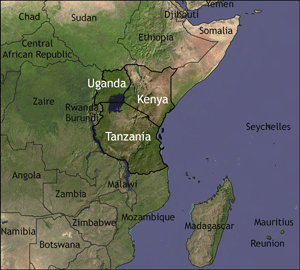Kenya, Uganda and Tanzania were recently joined by neighbouring Burundi and Rwanda as members of the East African Community. Together the countries cover an area of approximately 1.8 million square kilometres. The dramatic landscape, for which the region is known, is a product of the geologic forces that created the Great Rift Valley. Africa’s two highest peaks, Kilimanjaro and Mount Kenya, are both located here, as are the world’s second largest freshwater lake, Lake Victoria, and the world’s second deepest lake, Lake Tanganyika.

East Africa’s rich natural resources, including large tracts of arable land, made it a prime target of interest for the European powers of the 19th century. Tanzania, after passing from German to British colonial rule in 1918, achieved independence in 1961; the former British colonies of Uganda and Kenya became politically independent in 1962 and 1963, respectively. Following decades of single-party leadership – a system essentially still in effect in Tanzania – Kenya and Uganda have recently made the transition to multi-party democratic systems.
The countries of East Africa are characterised by a high degree of cultural and ethnic diversity. While the rate of population growth has declined markedly in recent decades, extreme demographic pressures continue to threaten the economic and political stability of the region.
Their largely rural economies have witnessed vast waves of internal migration. As population density in areas of high agricultural potential reached explosive levels, large population groups began to settle in neighbouring, semi-arid lands. Efforts to increase productivity in these areas led to the introduction of land use practices and farming methods incompatible with prevailing ecological conditions. This has contributed to a cycle of severe land degradation, declining productivity, and increased conflicts over resource use and access.
So far, both governmental and non-governmental programmes have, for the most part, failed to come to grips with the growing environmental challenges in the region or the social consequences that have accompanied them. Poverty and physical insecurity are widespread, social and economic dependence on external aid are rising.
Regional coordination of NCCR North-South activities in East Africa is based at the
Centre for Training and Integrated Research in Arid and Semi-Arid Lands Development (CETRAD) in Nanyuki, Kenya. Research in East Africa examines the social, political and environmental factors contributing to current pressures and seeks to develop measures to alleviate them now and in the future. Key topics include sustainable management of natural resources, adapting to climate change as well as securing health services, social services and livelihood opportunities for marginalised populations.
Regional Coordination
East Africa Regional Office
Boniface Kiteme (Regional Coordinator)
Centre for Training and Integrated Research in Arid and Semi-arid Lands Development (CETRAD) P.O.Box 144, Nanyuki, Kenya
Phone: +254 62 313 23 (office); +254 62 313 28 (secretariat)
Fax: +254 62 313 23
E-Mail:
b.kiteme@africaonline.co.ke
Related content
Display publications